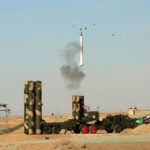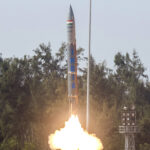What India’s MIRV test adds to the ‘strategic trilemma’ in South Asia
By Huma Rehman | May 3, 2024
 India successfully conducted its first test of an Agni-V ballistic missile with Multiple Independently Targetable Reentry Vehicle (MIRV) technology as part of Mission Divyastra on March 11, 2024. Although the technology is most probably aimed at China, Beijing continues to maintain a numerical and qualitative edge over New Delhi in nuclear weapons delivery capability. (Credit: DRDO / Government of India)
India successfully conducted its first test of an Agni-V ballistic missile with Multiple Independently Targetable Reentry Vehicle (MIRV) technology as part of Mission Divyastra on March 11, 2024. Although the technology is most probably aimed at China, Beijing continues to maintain a numerical and qualitative edge over New Delhi in nuclear weapons delivery capability. (Credit: DRDO / Government of India)
On March 11, India successfully tested a new multiple independently targetable re-entry vehicle (MIRV) technology on its Agni-V medium- to intercontinental-range ballistic missiles, sparking concerns about the country’s strategic ambitions. More broadly the test also added new uncertainties and deterrence challenges in the realm of missile defense technologies in South Asia.
The technological gap between China and India and the asymmetry in technological capability between Pakistan and India are driving each state’s current strategic posture. While the improvements and upgrades in defense inventory have raised significant concerns in the regional dynamics, potentially destabilizing technologies like MIRVs now risk fueling a full-scale arms race between China, India, and Pakistan.
India’s new MIRV technology poses a significant challenge to security analysts because of the absence of a regional crisis management framework that would reduce the risk of unintended escalation or accidental deployment of nuclear weapons. Without such a framework, a military crisis involving India, Pakistan, and China carries the possibility of inadvertently—or purposely—reaching the nuclear threshold. With the employment of MIRVs, this regional vulnerability increases significantly, calling for urgent risk reduction mechanisms to address the “strategic trilemma” in South Asia.
India’s most powerful missile capability yet. Technologically, the Agni-V intercontinental ballistic missile (ICBM) is a solid-fueled, three-stage, canisterized nuclear missile. The Agni-V was first tested by India in 2012, with subsequent tests over the years. With a range of more than 7,000 kilometers—enough to cover the entire Chinese mainland, including the densely populated eastern coast—the Agni-V seems a direct strategic signal to China. (India’s existing missile ranges already cover the entire landmass of Pakistan.)
While MIRVs can be mounted on India’s other ballistic missiles, including the submarine-launched K15 Sagarika and K4 missiles, the test of an Agni-V—India’s longest-range ballistic missile—fitted with MIRVs shows that India is now able to store and launch ICBMs with several nuclear warheads.
According to a former scientist with India’s Defense Research and Development Organization, this MIRVed missile could carry three to four warheads within the missile’s nose cone. These multiple warheads may be used to simultaneously attack one or several targets, requiring fewer launch locations and missiles to mount an attack than when employing single-warhead missiles.
The warheads being independently maneuverable, they can evade the opponent’s missile defense systems while traveling at hypersonic speeds. Decoy warheads can also be deployed on missiles fitted with MIRVs to overwhelm the adversary’s ballistic missile defense systems, making ballistic missiles fitted with MIRVs a powerful platform that may change the strategic ambitions of those possessing the technology.
Strategic implications. India’s progress with MIRVs has clear strategic ramifications that draw attention to its nuclear doctrine. India has adhered to a no-first-use principle since 1998, when the country went nuclear. Although New Delhi continues to claim it pursues only a credible minimum deterrent, the deployment of technologies that can serve as essential counterforce capabilities—like MIRVs—inherently broaden the scope of India’s doctrine.
China is well known for having both a strong ballistic missile defense program and a MIRV capability. And Pakistan has asserted that it possesses MIRV technology as well, after testing a MIRVed Ababeel medium-range ballistic missile, reportedly successfully, in 2017 and then again in October 2023.
MIRVs can increase the risk of a nuclear first use in a conflict. Their ability to evade and saturate missile defense systems may give an attacker the impression that a decapitating first strike is indeed possible. MIRVs also draw attention to the counter-force and counter-value targeting conundrum, raising at least the possibility that India, in this case, might launch a pre-emptive first strike against, for example, Pakistan, rather than absorb a Pakistani attack before responding. The ambiguity of no-first-use doctrines is not unique to India; a debate over the future of China’s no-first-use policy has also arisen under the pretext of advancement in its strategic capabilities.
India’s MIRV technology seems likely to alter the regional balance of power. In response, China and Pakistan may feel compelled to expand their own nuclear options and MIRV capabilities. MIRVs will make decision-making in a South Asian crisis more complex and therefore increase the risk of miscalculation or accidental use of nuclear weapons. In particular, the deployment of MIRVs may further erode the already precarious regional strategic environment between Pakistan and India by creating a first-strike scenario and, given the speed of MIRV technologies, closing a window for the exchange of signals and diplomatic communication in a crisis.
India’s MIRV prowess shows the contradiction between maintaining strategic stability and seeking a strategic advantage. The move suggests that an arms race in ballistic missile defense in South Asia could be on the horizon, as all three countries seek to offset MIRVs via increases in missile defense interceptors. But because it takes at least several interceptors to defeat an opponent’s MIRVed missile, India’s MIRVs could also spark an offensive missile arms race, because it is far less expensive to expand offensive than defensive capacity. That is, with MIRVs, it’s becoming cheaper to destabilize rather than stabilize a security environment.
How to reduce risks. In the absence of a risk reduction and crisis de-escalation framework in South Asia, every crisis poses the peril of nuclear escalation. The deployment of MIRVs raises the risk by a few marks, because expanded missile testing might be misinterpreted as war preparations or warfighting.
The nuclear risks that come with MIRVs call for immediate actions to maintain regional security and stability. One promising approach to mitigating this new challenge may require combining, coordinating, and expanding the bilateral missile flight-test pre-notification accords that already exist between India and China. This would accomplish multiple goals of improving the ability of the South Asian ballistic missile flight-test notification regime while securing the initial integration of China into regional nuclear confidence-building measures.
In addition, revisiting and proposing similar agreements on missile launch as a foundational element of an expanded and integrated regime could help future crisis management by reducing the risk of misinterpretation. For instance, under their 2005 missile launch accord, Pakistan and India have committed to informing each other of any planned five-day period within which a ballistic missile test will take place, with a three-day advance notice. The notification also includes a warning of the air and naval areas to be affected by the test.
Referring to the positive development of India-Pakistan relations in 2021, the two sides have renewed the 2003 ceasefire commitment on the Line of Control (a demarcation that separates Indian- and Pakistani-controlled parts of disputed Kashmir and serves as the de facto boundary between the two countries) and other parts of their international border. The restoration of this ceasefire agreement was a significant step toward risk reduction, although not a permanent conflict resolution. Such engagements pave the way for a crisis management framework and should be expanded to all three South Asian countries with nuclear weapons.
Ironically, despite efforts in several domains, there is no formal mechanism for cross-domain diplomacy in the region. To fill this gap, dedicated channels of communication between China and India and Pakistan and India must be established to engage all three states in active risk reduction. Simulation exercises in “track 2” regional engagement efforts could also open a platform of communication for assessing the South Asian strategic trilemma.
With increasingly complex nuclear competition between China, India, and Pakistan likely ahead, negotiating and proposing cooperation agreements should be a priority in diplomacy on security and regional strategic stability in South Asia.
Together, we make the world safer.
The Bulletin elevates expert voices above the noise. But as an independent nonprofit organization, our operations depend on the support of readers like you. Help us continue to deliver quality journalism that holds leaders accountable. Your support of our work at any level is important. In return, we promise our coverage will be understandable, influential, vigilant, solution-oriented, and fair-minded. Together we can make a difference.















We cannot firm up strategy first and then fit the weapon system needed .Strategy and development go hand in hand.This writing reflects a traditional old school thought on how India at best to on Par with Pakisthan.This is a Nehruvian thinking practiced for decades providing more space for our opponents so that India to be on par or less than Pakisthan.Did China implement strategy first and then became an atomic power.Every nation creates the strategy needed to go for any offensive systems.It is not like thinking in vaccume and zero sum game by many in this country
Huma has nicely and clearly highlighted the concerns in South Asia. However, her opinion about India following a No First Use (NFU) policy since 1998 is misleading. India follows a conditional NFU policy since 1999 which is neither valid against nuclear weapons possessor states nor their allies. Moreover, the NFU was made further redundant in 2003 by adding conditions of right to respond to chemical and biological agents attack against Indian troops anywhere in the world.